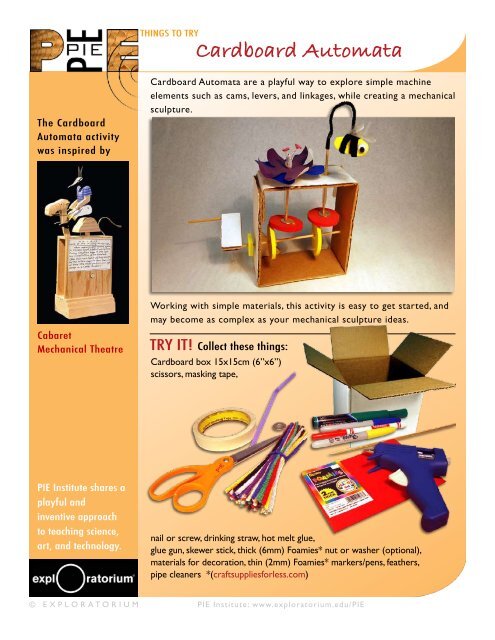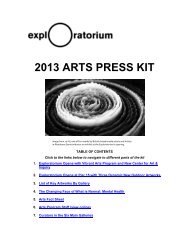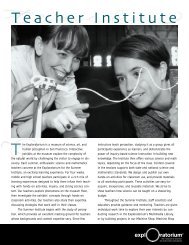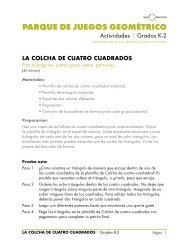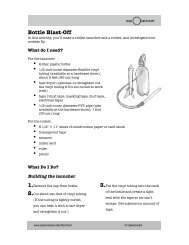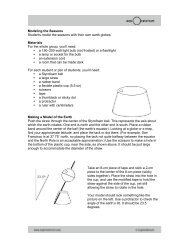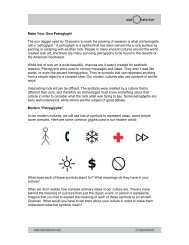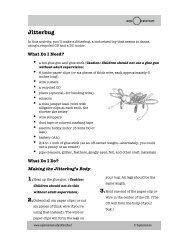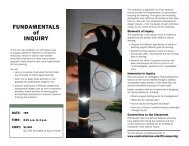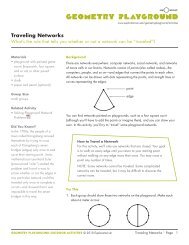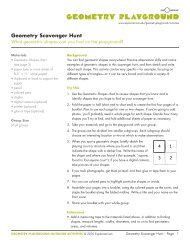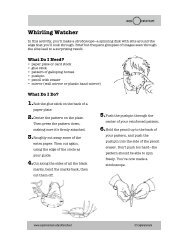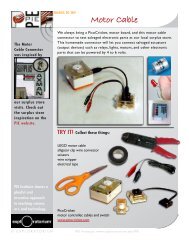Cardboard Automata - Exploratorium
Cardboard Automata - Exploratorium
Cardboard Automata - Exploratorium
Create successful ePaper yourself
Turn your PDF publications into a flip-book with our unique Google optimized e-Paper software.
The <strong>Cardboard</strong><br />
<strong>Automata</strong> activity<br />
was inspired by<br />
Cabaret<br />
Mechanical Theatre<br />
PIE Institute shares a<br />
playful and<br />
inventive approach<br />
to teaching science,<br />
art, and technology.<br />
THINGS TO TRY<br />
<strong>Cardboard</strong> <strong>Automata</strong><br />
<strong>Cardboard</strong> <strong>Automata</strong> are a playful way to explore simple machine<br />
elements such as cams, levers, and linkages, while creating a mechanical<br />
sculpture.<br />
Working with simple materials, this activity is easy to get started, and<br />
may become as complex as your mechanical sculpture ideas.<br />
TRY IT! Collect these things:<br />
<strong>Cardboard</strong> box 15x15cm (6”x6”)<br />
scissors, masking tape,<br />
nail or screw, drinking straw, hot melt glue,<br />
glue gun, skewer stick, thick (6mm) Foamies* nut or washer (optional),<br />
materials for decoration, thin (2mm) Foamies* markers/pens, feathers,<br />
pipe cleaners *(craftsuppliesforless.com)<br />
© E X P L O R A T O R I U M PIE Institute: www.exploratorium.edu/PIE
MAKE A FRAME<br />
Cut triangles out of the<br />
flaps and tape them into each<br />
corner of the frame for support.<br />
Cut the flaps off the box,<br />
then cut the box in two pieces<br />
(you get two frames from each box)<br />
Things to Tr y: <strong>Cardboard</strong> <strong>Automata</strong> PIE Institute: www.exploratorium.edu/PIE Page 2
Choose a<br />
Motion<br />
Round and Round<br />
Up and Down,<br />
Round and Round<br />
Up and Down,<br />
Back and Forth<br />
Things to Tr y: <strong>Cardboard</strong> <strong>Automata</strong> PIE Institute: www.exploratorium.edu/PIE Page 3
More<br />
Options<br />
Up and Down<br />
Side to Side<br />
MAKE THE CAMS<br />
Draw your cam and cam follower on the<br />
thick Foamie sheet, and cut them out.<br />
The cam should be about 2.5” (6cm)<br />
in diameter.<br />
Tip: Cut the cams smoothly,<br />
and make sure the cam follower<br />
is a little bigger than the cam.<br />
Things to Tr y: <strong>Cardboard</strong> <strong>Automata</strong> PIE Institute: www.exploratorium.edu/PIE Page 4
Make the Axle<br />
Put your cam on a skewer<br />
stick inside the frame.<br />
Tip: Start the holes in the frame<br />
using a nail or screw, and make<br />
sure the cam clears the top and<br />
bottom of the frame.<br />
Make the Handle<br />
Glue a small rectangle<br />
cut from the cardboard box flap<br />
to the skewer stick axle.<br />
Glue a second piece of skewer<br />
stick to the end of the rectangle<br />
to make a handle.<br />
Add the Cam Follower<br />
Poke a hole in the top of the frame where you want your cam follower to be located,<br />
and insert a drinking straw. Carefully glue the drinking straw in place.<br />
Tip: Use a pencil to make the<br />
hole large enough for the<br />
drinking straw.<br />
Things to Tr y: <strong>Cardboard</strong> <strong>Automata</strong> PIE Institute: www.exploratorium.edu/PIE Page 5
Glue your cam follower on<br />
the end of a skewer stick<br />
and put it through the straw.<br />
Tip: The straw will keep the<br />
skewer stick from falling over.<br />
Tip: If the cam follower does<br />
not fall on the cam,<br />
attach a washer or nut to<br />
add a little weight.<br />
Test it!<br />
Tip: If your cam and axle move<br />
out of place, add a small<br />
bushing made from a scrap piece<br />
of a thick Foamie.<br />
Adjust your cam under the<br />
cam follower until you get the<br />
motion you like, then GLUE<br />
the cam into place on the<br />
skewer stick axle.<br />
Tip: Make sure to glue the bushing<br />
to the axle and NOT to the frame.<br />
Things to Tr y: <strong>Cardboard</strong> <strong>Automata</strong> PIE Institute: www.exploratorium.edu/PIE Page 6
DECORATE YOUR AUTOMATA<br />
Things to Tr y: <strong>Cardboard</strong> <strong>Automata</strong> PIE Institute: www.exploratorium.edu/PIE Page 7
MAKE YOUR AUTOMATA<br />
COIN OPERATED:<br />
Make a coin detector switch<br />
from three popsicle sticks,<br />
aluminum foil, masking tape,<br />
and a PicoCricket resistance sensor.<br />
www.picocricket.com<br />
The skewer stick axle fits<br />
nicely into a LEGO motor.<br />
TAKING IT FURTHER<br />
You can build automata out of a<br />
variety of everyday materials.<br />
Program a PicoCricket to send<br />
power to a LEGO motor when it<br />
detects a coin completing the<br />
circuit in a coin detector.<br />
Things to Tr y: <strong>Cardboard</strong> <strong>Automata</strong> PIE Institute: www.exploratorium.edu/PIE Page 8
WHY IS THIS A PLAYFUL AND INVENTIVE EXPLORATION?<br />
• A playful and inventive approach to learning simple machines<br />
This is a playful and inventive way of exploring levers, cams, cam followers, linkages, and<br />
other mechanisms.<br />
• Science and art connections<br />
<strong>Cardboard</strong> <strong>Automata</strong> are a good example of integrating science and art into an activity.<br />
For learners, the narrative, decorated aspects of the automata are as important as the<br />
mechanical elements.<br />
• Connections to other activities and the real world<br />
This activity is a good introduction to a variety of mechanisms and systems found in other<br />
PIE activities, and in the real world.<br />
Things to Tr y: <strong>Cardboard</strong> <strong>Automata</strong> PIE Institute: www.exploratorium.edu/PIE Page 9
RELATED IDEAS<br />
Peter Markey is an artist who often<br />
makes whimsical automata out of wood,<br />
utilizing cams and cam followers as his<br />
main source of movement.<br />
www.focsle.org.uk/first/markey<br />
www.cabaret.co.uk/artists/markey/htm<br />
The <strong>Cardboard</strong> <strong>Automata</strong> activity is a good introduction to another PIE activity called Sound <strong>Automata</strong>.<br />
Sound <strong>Automata</strong> introduce the idea of creating automata out of everyday objects in order to generate a<br />
variety of sounds and noises.<br />
Download the<br />
Sound <strong>Automata</strong> Activity PDF<br />
from the PIE website.<br />
This material is based on work supported by the National Science Foundation under Grant No. ESI-04-52567.<br />
Any opinions. findings, and conclusions, or recommendations expressed in this material are those of the author(s)<br />
and do not necessarily reflect those of the National Science Foundation.<br />
Things to Tr y: <strong>Cardboard</strong> <strong>Automata</strong> PIE Institute: www.exploratorium.edu/PIE Page 10


